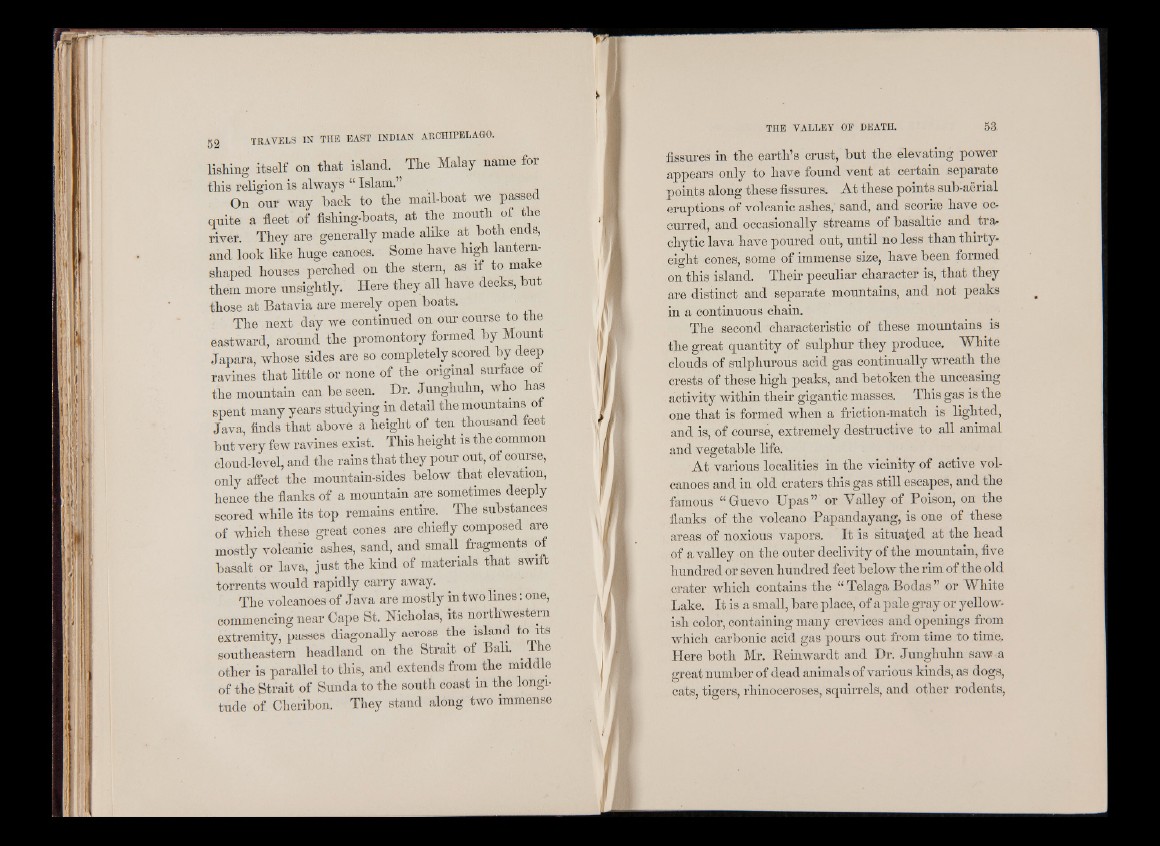
lin in g itself on that island. The Malay name for
this religion is always “ Islam.”
On our way hack to the mail-hoat we passed
quite a fleet of fishing-hoats, at the mouth of the
river. They are generally made alike at hoth ends,
and look like huge canoes. Some have high lanternshaped
houses perched on the stern, as if to make
them more unsightly. Here they all have decks, hut
those at Batavia are merely open boats.
The next day we continued on our course to the
eastward, around the promontory formed hy Mount
Japara, whose sides are so completely scored hy deep
ravines that little or none of the original surface of
the mountain can he seen. Dr. Junghuhn, who has
spent many years studying in detail the mountains of
Java, finds that ahove a height of ten thousand feet
hut very few ravines exist. This height is the common
cloud-level, and the rains that they pour out, of course,
only affect the mountain-sides below that elevation,
hence the flanks of a mountain are sometimes deeply
scored while its top remains entire. The substances
of which these great cones are chiefly composed are
mostly volcanic ashes, sand, and small fragments of
hasalt or lava, just the kind of materials that swift
torrents would rapidly carry away.
The volcanoes of Java are mostly in two lines: one,
commencing near Cape St. Nicholas, its northwestern
extremity, passes diagonally across the island to its
southeastern headland on the Strait of Bali. The
other is parallel to this, and extends from the middle
of the Strait of Sunda to the south coast in the longitude
of Cherihon. They stand along two immense
fissures in the earth’s crust, hut the elevating power
appears only to have found vent at certain separate
points along these fissures. At these points sub-aerial
eruptions of volcanic ashes, sand, and scoriae have occurred,
and occasionally streams of hasaltic and tra-
chytic lava have poured out, until no less than thirty-
eight cones, some of immense size, have heen formed
on this island. Their peculiar character is, that they
are distinct and separate mountains, and not peaks
in a continuous chain.
The second characteristic of these mountains is
the great quantity of sulphur they produce. White
clouds of sulphurous acid gas continually wreath the
crests of these high peaks, and hetoken the unceasing
activity within their gigantic masses. This gas is the
one that is formed when a friction-match is lighted,
and is, of course, extremely destructive to all animal
and vegetable life.
At various localities in the vicinity of active volcanoes
and in old craters this gas still escapes, and the
famous “Guevo Upas” or Valley of Poison, on the
flanks of the volcano Papandayang, is one of these
areas of noxious vapors. It is situated at the head
of a valley on the outer declivity of the mountain, five
hundred or seven hundred feet helow the rim of the old
crater which contains the “ Telaga Bodas ” or White
Lake. It is a small, hare place, of a pale gray or yellowish
color, containing many crevices and openings from
which carbonic acid gas pours out from time to time.
Here hoth Mr. Reinwardt and Dr. Junghuhn saw a
great number of dead animals of various kinds, as dogs,
cats, tigers, rhinoceroses, squirrels, and other rodents,